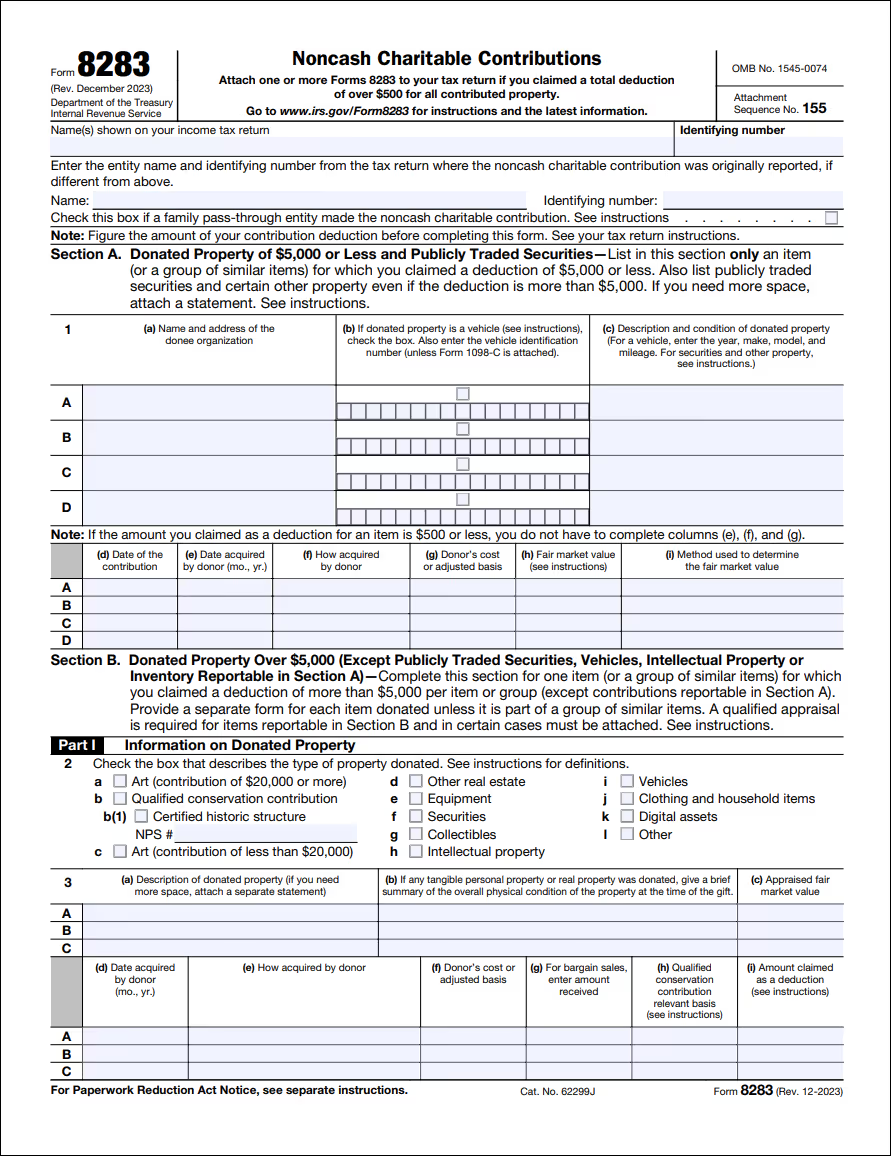We all want to save more come tax season. Charitable contributions are a well-known way to lessen your tax burden while improving your community. You might already count on deducting your cash donations to your favorite local organization each year.
But there are other, less-used charitable giving methods to save even more on your taxes. It’s not just a matter of giving more; it’s also a matter of how you choose to donate to organizations.
Donating appreciated securities that have been held for a year or more can provide double tax benefits — namely, a tax deduction for the full fair market value of your donated securities and the avoidance of capital gains taxes on their increased value. Explore our full guide to donating stock to charity to learn how.
In this article, we’ll look specifically at what you need to do to realize the tax benefits of stock donations. Here’s what we’ll cover:
- The tax benefits of donating stock
- Choosing stock to donate to maximize tax benefits
- The importance of stock donation receipts
- Understanding Form 8283
- Next steps for stock donors
The information in this article is provided for educational purposes only and should not be construed as providing legal or tax advice. This information is general and is not intended to serve as the primary or sole basis for investment or tax-planning decisions.
Quick Tips:
- When donating stock, pick those with the highest appreciated gains that you’ve held for longer than a year.
- Deducting stocks from your taxes is easy to do by filling out the right form (8283) or entering it in your tax preparation tool.
- You can use FreeWill to make a stock donation in 10 minutes or less.
The tax benefits of donating stock
Let’s recap one of the biggest benefits of donating stock to charity. It can save you big for one simple reason: capital gains tax.
Here’s an example scenario to illustrate how this benefit works:
- Let’s say you bought 15 shares of Apple stock in August 2019 for $788.85.
- In August 2024, those same shares are worth around $3,139 each. That represents a gain of $2,350 per share.
- You might be thinking about selling off the shares and using the proceeds for your charitable contribution this year, so you can deduct a large amount from your taxes.
- You’re off to a great start — but wait before you sell that stock!
- If you sell the shares and realize the gain, you will have to pay capital gains tax up to 20%. In this case, you’d pay around $628 in taxes.
- That would leave you with $1,722 of your cash proceeds to donate.
- Instead, if you donate the 15 shares, neither you nor the organization has to pay capital gains tax.
- The organization will receive the full $3,139, and that’s what you’d write off on your 2024 taxes.
That extra $628 can make a huge difference to any organization working on a tight budget. Plus, you get to bypass capital gains tax. It’s a win-win!
How FreeWill simplifies stock donations
Contrary to what you might assume, donating stock isn't a complicated process. Services like FreeWill streamline the entire process, minimizing the tasks you have to complete and ensuring the organization receives your gift quickly.

Simply gather some information about the stock to be donated and fill out a form from your brokerage, which FreeWill can automatically pre-populate with the stock information. Forward this form to your broker (we’ll tell you how), then receive your tax receipt from the nonprofit to claim the tax deduction. The whole process takes 10 minutes or less.
It’s also possible to handle the stock donation yourself the old-fashioned way. This process requires a few additional steps and coordination with your broker.
Whichever route you take, make sure you know what information to track so you can deduct the correct amount from next year’s taxes. We’ll discuss the importance of gift documentation below.
Do you own cryptocurrency?
FreeWill can help you donate your crypto to save on taxes, too!
Choosing stock to donate to maximize tax benefits
If you want to donate stock, take the time to fully understand what you’ll need to do to get the biggest deduction possible.
The most important point to know: Choose the stock with the highest gains to maximize your tax savings.
Additionally, make sure you donate appreciated stock you’ve held for at least a year. Short-term capital gains are subject to different tax rates and rules. If you generate a short-term capital gain from the sale of stock, then you have to subtract the appreciation from the current fair market value to calculate your deduction.
This is why it’s best to donate stock you have held for a year or more. After a year, it’s no longer considered a short-term capital gain, and you can deduct the full fair market value without subtracting your basis.
On the flipside: If you’re considering donating a losing stock, the opposite approach is better. Sell the stock and take the capital loss. Then, donate the cash value directly to your desired organization. You may also be able to deduct capital losses or make the transaction part of a larger tax-loss harvesting strategy.
Also, be prepared to take an itemized deduction. If you take a standard deduction, there will be no way for the full value of your donation to be reflected in your taxes. You also cannot currently claim charitable deductions if you do not itemize your taxes.
(For some donors, the total itemized deductions you might claim could end up smaller than your standard deduction. If you’re unsure if you’ll be able to claim enough itemized deductions in the year, do some math beforehand or consult a tax professional for guidance.)
Finally, if you have been granted stock options by your employer, we recommend you exercise the options and hold the stock for at least one year before donating. If you donate the shares before the one-year limit is up, your deduction will be limited to the exercise price.
The importance of stock donation receipts
Documented gift substantiation, aka donation receipts, is essential for claiming itemized tax deductions.
To claim a deduction for any gift (cash or property, including stock) greater than $250, you’ll need substantiation. For non-cash gifts, deduction amounts are generally determined by the donation’s fair market value at the date of receipt by the nonprofit.
For larger gifts, the IRS requires additional documentation steps:
You must fill out one or more Forms 8283, Non-cash Charitable Contributions and attach them to your return, if your deduction for each non-cash contribution is more than $500. If you claim a deduction of more than $500, but not more than $5,000 per item (or a group of similar items), you must fill out Form 8283, Section A. If you claim a deduction of more than $5,000 per item (or a group of similar items), you must obtain a qualified appraisal of the item or group of items and fill out Form 8283, Section B.
To fill out these forms, you’ll need proof of receipt from the organization(s). These receipts should clearly state what was donated—a certain number of shares of stock from a certain corporation received on a specific date.
Keeping track of your tax deductions
Anyone can tell you that taxes get complicated. This is especially true if you itemize your taxes. Keeping close track of your deductions and documentation throughout the year is essential.
You might do this in one of a few ways:
- If you use tax software each year, your platform likely includes tools for recording deductions throughout the year to later auto-populate into your tax forms.
- TurboTax also offers a standalone program, ItsDeductible, for anyone to track deductions and then later import into TurboTax.
- You can always track deductions manually in a Google Spreadsheet or Excel file. Make a row for each donation, and list all the relevant information from each donation (specified below). Have a designated digital or physical folder to save gift receipts.
The most important thing is to have a system that serves you well come tax season. If a filing cabinet has worked for you for the past 20 years, great! No need to mess with success — just make sure your process saves you headaches rather than causes them.
Understanding Form 8283
Form 8283 is the Non-cash Charitable Contributions form for the 1040 tax return.
If you’re using a tax service, they’ll ask you for the appropriate information to populate this form. Either way, you’ll need to have the right information at the ready, including:
- The name and the address of the organization you donated to
- Description of the donated property (the number of shares and the name of the company)
- Date of contribution
- The fair market value of the property (market value)
- The method used to determine the fair market value
- Date acquired by the owner (month and year)
If you don’t use a tax service, you’ll need to fill out Form 8283 manually. Here’s what to expect:

Section A on page 1 of Form 8283 is for non-cash donations valued at greater than $500 but less than $5,000. It’s a pretty straightforward process — provide information about the nonprofit, the donation, and its fair market value at the time of receipt.
For non-cash donations valued at greater than $5,000, you’ll need to complete the extra steps of Section B, which continues on page 2:

Note that gifts greater than $5,000 require independent appraisal to determine the correct deduction amount. Parts 3 through 5 of Section B are for providing appraisal information and acknowledgment from you, the appraiser, and an authorized individual from the nonprofit.
If you’re using tax software
If you use tax software like TurboTax or CreditKarma, these platforms should include easy steps to guide you through the process of itemizing your charitable contributions for deductions.
Look for sections or options about “contributions to charity” or “itemized deductions.” Ensure that the platform supports Form 8283. Then, provide all the same details that you would if you were completing the form manually.
If you’re unsure whether you’re using the right forms or prompts in your tax software, stop to confirm you’re in the correct place before moving forward.
Next steps for stock donors
As you consider and make donations of stock to charity, keep this article handy. We hope it will serve as a helpful reminder of everything you’ll need from your chosen organizations, the stock donation service you’re using, and/or your broker. Then, track the information digitally or put it in a safe place where you’ll be able to easily reference it come tax season.
One more tip for year-end donors: If you’re making a big year-end contribution, start the process early! There’s nothing worse than a donation being fully received and substantiated on January 2 instead of December 30, and more complex transactions can take a few days to process.
Avoid this (and tons of other potential logistical hiccups) by using a stock giving platform like FreeWill to streamline the entire process of donating appreciated stock.
Remember, stock donations don’t have to be complicated, and deducting them from your taxes doesn’t have to be, either!
To learn more about non-cash giving and its benefits, explore these additional resources from the FreeWill team:
Make your free estate plan today

Make your free advance healthcare directive

Make your free durable power of attorney

Make a stock donation today

Make your free revocable living trust










